Last Chance to Catch NYC's Holiday Notalgia Train
We met the voices of the NYC subway on our nostalgia ride this weekend!



Image from Library of Congress
After noticing how many “fake” mews there are around New York, we decided to look into actual mews that have been preserved from the 19th century. Before the automobile, when the only way to get around was on a horse or being draw by one in a carriage, horses inhabited the city and actually played a huge role in its functioning. These valuable horses needed stables where they could rest and be cared for, so owners bought land and built rows of stables and carriage houses–also known as mews.
When the automobile took over and the mews were no longer needed many of these rows were destroyed, but thankfully some were converted for residential or commercial purposes. Converted mews and carriage houses that have been carefully preserved give us a glimpse into the past; a New York lost to the modern age. Here we share 9 of NYC’s remaining mews.

Verandah Place in Brooklyn’s Cobble Hill Historic District is a charming little street that seems to transport one back to the neighborhood’s mid-nineteenth century origins. Rather than being frozen in time, however, its attractive character is due not only to the small scale of its quaint rowhouses, but also to the adjoining park that was created in the 1960s and which both altered and enhanced its historic context.
More a mews for the horse drawn carriages of Brooklyn’s past than a proper street, Verandah Place (also sometimes spelled Veranda Place) is a block and a half long and just 20 feet wide, including the narrow sidewalk along its south side. It was created as a service alley as the area urbanized and the street grid was laid out in the years prior to the Civil War.
Between Henry and Clinton streets its south side is lined with a picturesque row of small brick residences, mostly three stories, that are built up to the sidewalk. Some of these structures were originally built as stables and later converted to residential use and others were built as homes for local workers and originally referred to as cottages. Ironically, there are no verandahs to be found on this street.

The Washington Mews is a little street that runs between 5th Avenue and University Place, parallel to Washington Square North and 8th Street. Visitors are often surprised by the quaintness and quiet of the street, the endearing European carriage houses and vines that seem to belong to another time completely. The once-stables housed horses of wealthy landowners nearby. A 1881 order from the Department of Public Works ordered gates to be built on both east and west ends to make the distinction between street and mews even more clear. Still privately owned by NYU, the mews are accessible to the public, but maintain an elegant quaintness uncommon in New York.
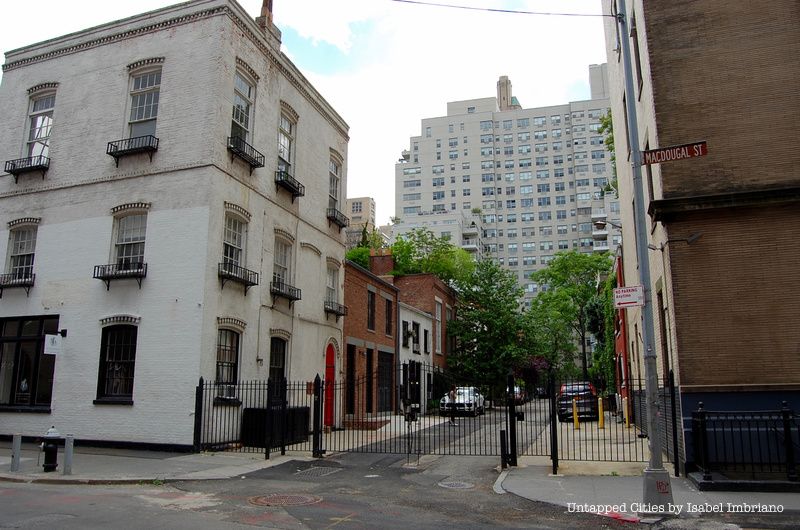
The nearby MacDougal Alley, a private cul-de-sac off of MacDougal Street, shares a similar history with Washington Mews. Nearby residents of the Washington Square area used the alley for stables starting in 1833 through the early 1900s. The numbers of the corresponding townhouses on Washington Square North and 8th Street can still be seen from the small street. This half-block alley actually has quite an artistic history; Jackson Pollock lived in one of the small houses from 1949-1950, as did poet Edward Arlington Robinson, and Getrude Vanderbilt Whitney had her art studio here as well before founding the Whitney Museum of American Art around the corner on 8th Street.
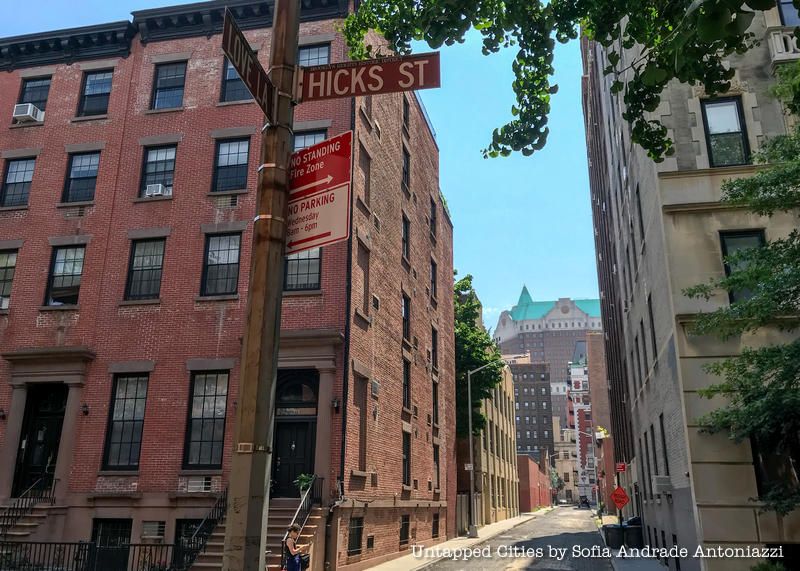
This Brooklyn Heights lane was originally a trail used by Native Americans, then got the name Lover’s Lane as quoted in a 1894 New York Times article. Today, these converted mews are famously expensive and luxurious homes. For a complete history of Love Lane and some guesses on how it got its endearing name, see Love Lane’s Carriage Houses Carry Echoes of a Brooklyn Past.
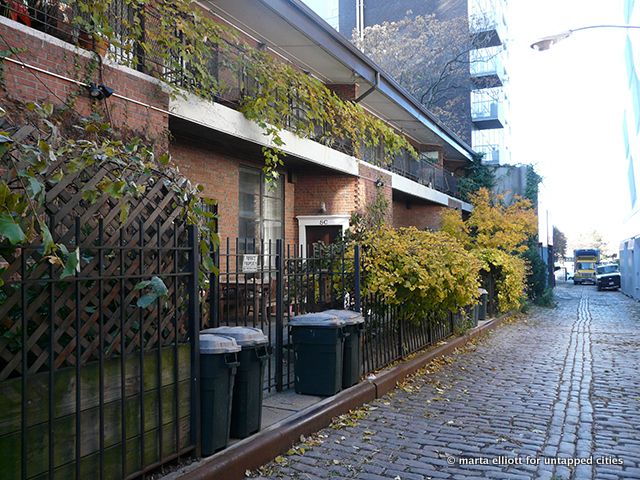
Charles Lane is a cobblestone alley between Washington St. and West St. by the Hudson River. In the 19th century, Charles Lane marked the northern boundary of the Newgate State Prison. The prison was torn down in 1829, but Charles Lane remained and warehouses and stables along the single-block street were converted into residences. One of the houses in the alley is curiously lined with Pez dispensers and just around the corner on Charles Street is a farmhouse that was moved here from the Upper East Side.

View down Sylvan Court from 121st Street.
The late 19th century stables on Sylvan Court in Harlem were turned into homes around 1900, but soon fell into disrepair. The houses on the street are a red brick Italianate style of townhouses. Some windows on the small street were boarded up and the paved street became a dirt path further into the complex. But the residences and street have undergone renovations and were put back on the market. Sylvan Court is also little of, if not all of, what remains of the Harlem Old Eastern Post Road that once connected New York and Boston.
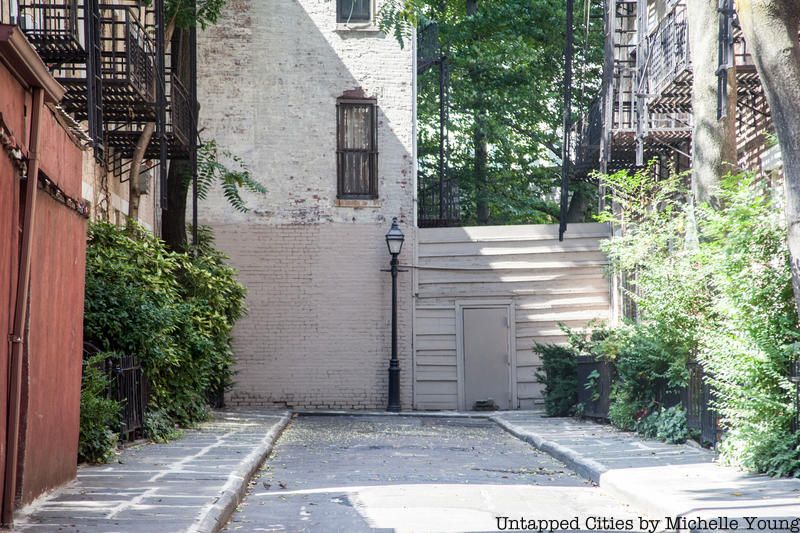
Built on the site of a former farm, Patchin Place is often referred to as a mews, in publications like The New York Times and The New Yorker, to name a couple). The houses that stand, built in around 1848, were always residential, built some say originally as boarding houses. The street is known for having housed Theodore Dreiser, Djuna Barnes, and perhaps most famously e.e. Cummings at 4 Patchin Place from 1913 until he died in 1962. Marlon Brando’s sister also resided here, where Brando reportedly roomed briefly in 1943. It also has the last 19th century gaslight lamp post (now electrified) in New York City.


This wonderful row of carriage houses, between 3rd Avenue and Lexington Avenue, got their name from their architect, John Sniffen. Midtown never had many alleys, but Sniffen Court‘s ten carriage houses have remained since 1860. The brick buildings were used as stables until the 1920s, and still feature plaques of horsemen by Malvina Hoffman on the rear wall (seen above). In 1967, The Doors used Sniffen Court for the cover of their Strange Days album. See the album cover here for proof that the landmarked mews have barely changed in almost 40 years. It’s also one of the city’s historic districts that are smaller than a city block.
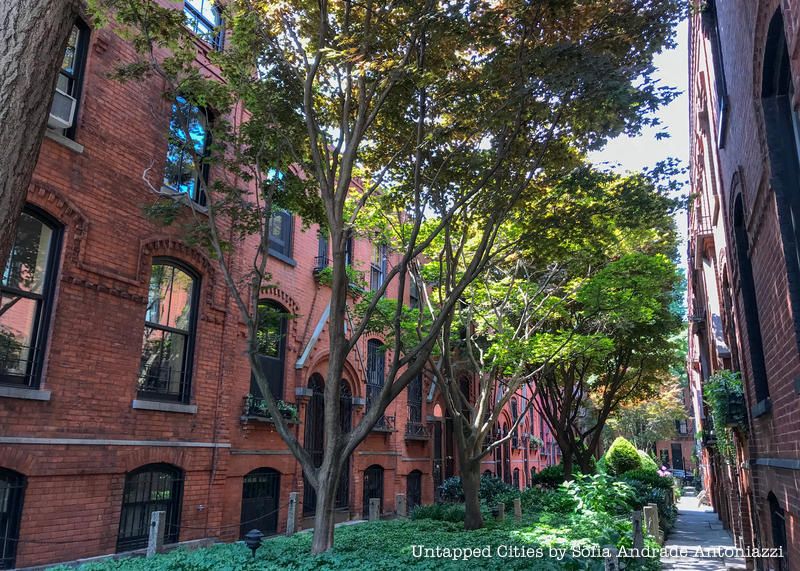
What most residents of Cobble Hill call “Warren Place Mews” is a block-long row of townhomes from the 1870s. The 34 homes were built for working class families and is considered one of the loveliest affordable housing projects. Simon Rich, writer for SNL, lives in one of the Warren Place townhouses. These were not actually mews back in the day but this street is so cute we couldn’t bear to leave it off of our list.
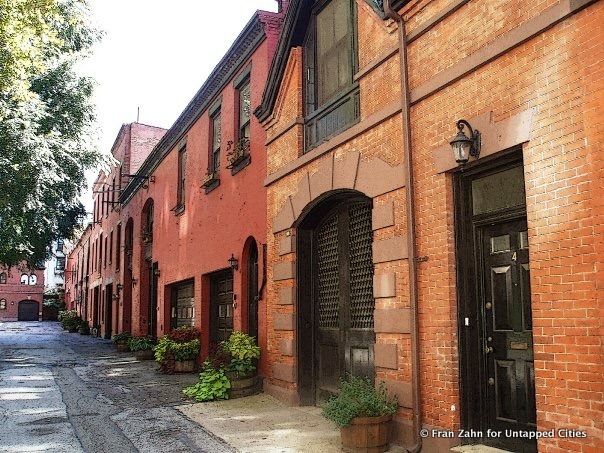
Grace Court Alley in Brooklyn Heights originally housed the stables of the Remsen family who lived in a mansion nearby during the 19th century. The mews got its name when Grace Church was built across the street in 1847 and used the stables for the church. Then automobiles replaced carriages and the mews at Grace Court Alley were paved and used as car garages by residences nearby. As development continued and demand for housing increased, the buildings were converted into lovely little apartments.
For more “mews,” check out all these fake mews in NYC, then read about 15 of NYC’s one block streets and 10 of NYC’s smallest historic districts.
Subscribe to our newsletter